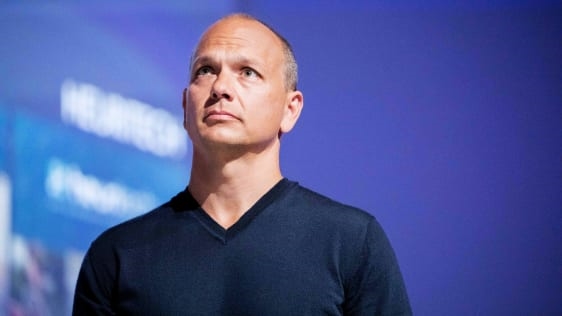Even One Of The iPhone’s Co-Creators Thinks Apple Should Own Up To Teen Cell Phone Addiction
The co-creator of the iPhone is speaking out about the need to limit the use of the iconic device by kids.
On Sunday, Tony Fadell unloaded in a tweet storm apparently touched off by an article in the Wall Street Journal titled “iPhones and Children Are a Toxic Pair, Say Two Big Apple Investors” (paywall).
The two investors, JANA Partners LLC and the California State Teachers’ Retirement System, say they’re concerned about the mental health costs of excessive cell phone use by kids, and that they’d like to talk to the Apple board about ways of addressing the problem. The two groups collectively hold about $2 billion in Apple shares.
From a purely capitalist point of view, an investor asking a company to limit the use of its product by paying customers sounds a little counterintuitive. But Jana and CalSTRS are thinking long term. From their January 6 letter to Apple:
“In the case of Apple, we believe the long-term health of its youngest customers and the health of society, our economy, and the Company itself, are inextricably linked, and thus the only difference between the changes we are advocating at Apple now and the type of change shareholders are better known for advocating is the time period over which they will enhance and protect value,” writes JANA managing partner Barry Rosenstein.
Concerns about cell phone addiction flare up occasionally, but this time may be different because the complaints are coming from within Apple’s network of friends. Fadell retweeted the WSJ article Sunday then launched into a tweet storm about the dangers of excessive cell phone use–to kids and adults. He also had some parenting suggestions for people whose kids are glued to their little black mirrors.
10/10
With (or without) these tools, it’s up to us to act:
Screen time rules, living in the moment, screen-free meals, relearning analog objects like books & writing & sketching, tech-free days for the family to be together. (And yes it’s ironic I’m tweeting this…) ?? https://t.co/wWBQNMdsYK— Tony Fadell (@tfadell) January 8, 2018
There’s plenty of research to back up the investors’ (and Fadell’s) concerns.
A 2017 study conducted by the University of Basel (Switzerland) found that many adolescents use their smartphones in bed at night, which often cuts into sleep time and in turn leads to depressive symptoms.
Another study at the Payame Noor University in Iran found cell phone addiction and depression linked in another way. Kids with depressive symptoms, the researchers wrote, are far more likely to develop cell phone addiction than mentally healthy kids.
A study at the University of San Diego found that U.S. teenagers who spend three hours a day or more on electronic devices are 35% more likely to have “a risk factor” for suicide. Kids who spend five hours or more a day are 71% more likely to have the risk factor. A schoolteacher quoted in the study said many kids no longer go outside for noon recess, preferring to stay indoors and play on their cell phones.
And so on.
The public interest group Common Sense has been waving this flag for a long time now, with things like its #DeviceFreeDinner campaign. “We are very pleased to see that leading shareholders have spoken out about their concerns for the health and safety of kids on cell phones and online,” said Common Sense founder and CEO James Steyer. “It is a hugely important development for shareholders to take public action like this on digital addiction and inappropriate cell phone behavior.”
Fadell suggested weening kids off their phones by reintroducing them to analog devices like books, or instituting “tech-free” days. Those are social and behavioral things; but he also has some ideas for safeguards at the device operating system level. For example, he says devices like the iPhone should tell the user how much on-device time they have, and warn them when they’re moving toward addiction-level use.
Fadell says it’s not just Apple. Google should respond, too. “They’re the only ones who can do this–they own the OS & app ecosystem,” Fadell wrote. “They need to do more, like single-use device modes: When I’m reading an ebook on my tablet, listening to music (ala iPod)…no email or facebook notifications, no texts.”
The question is whether Apple or Google would ever build cell phone use controls for kids into the phone operating system itself. Very recently Apple added a “do not disturb while driving” mode to iOS that shuts down the iPhone’s notifications and encourages the driver to focus on the road. Would kid use controls be so different?
Both Tim Cook and Jony Ive have spoken publicly about designing technology that frees up the user to engage in real life. They espouse the idea of enabling people to spend less time with their devices, and making the time they do spend with them highly valuable. The “glance-able” Apple Watch is an expression of that concept, but the iPhone? Not so much.
To begin dealing with the cell phone abuse problem, Apple might be forced to start thinking in a way that feels counterintuitive–even countercultural. Apple (and its app developer partners) has spent years trying to make its devices more vital, more sticky, (and more time consuming). Shifting that mindset toward one of “responsible use” might seem as foreign to it (and all connected device companies) as it once did to the tobacco companies.
“Apple Watches, Google Phones, Facebook, Twitter – they’ve gotten so good at getting us to go for another click, another dopamine hit,” Fadell tweets. “They now have a responsibility & need to start helping us track & manage our digital addictions across all usages – phone, laptop, TV etc.”
Fast Company , Read Full Story
(15)



